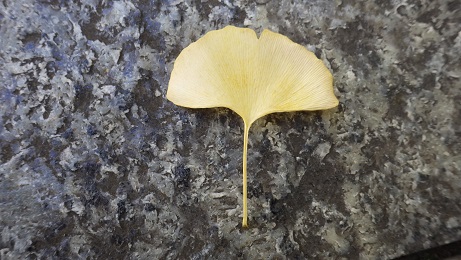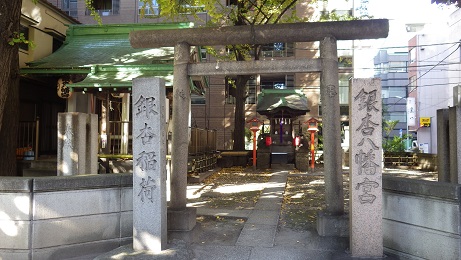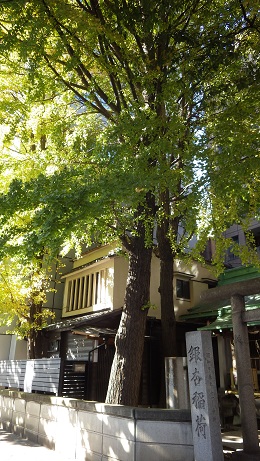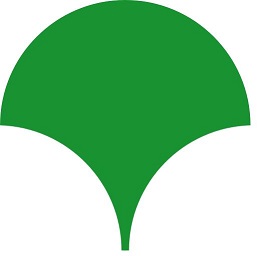In this season when it gets colder day by day, the yellow leaves of ginkgo (ginkgo) that lets you enjoy your eyes.  In Chuo-ku, correspondent Sam's December 3 article "Ginkgo Yellow Leaves (Ginkgo Leaves)
In Chuo-ku, correspondent Sam's December 3 article "Ginkgo Yellow Leaves (Ginkgo Leaves)
/archive / 2015/12/post-2914.html) "is at its best in various places such as the Hamacho Park Entrance Green Road introduced in ".
On Saturday of a holiday, after finishing recording "I love Chuo-ku" at Chuo FM Studio in Kyobashi Square Garden, the weather is fine, so I was flowing through the city on the Chuo-ku Community Cycle (CC![]() C) borrowed from the port of Yanagi-dori St. I found a corner that turned golden along Shin-ohashi-dori St. in Kakigara-cho. When I stopped my bicycle immediately, there is a torii gate, and the letters of Ginkgo Inari and Ginkgo Hachimangu Shrine on the left and right.
C) borrowed from the port of Yanagi-dori St. I found a corner that turned golden along Shin-ohashi-dori St. in Kakigara-cho. When I stopped my bicycle immediately, there is a torii gate, and the letters of Ginkgo Inari and Ginkgo Hachimangu Shrine on the left and right.
 There is a large ginkgo tree on the grounds, and it is entirely golden. The exact foundation of this Hachimangu Shrine is unknown, but it is said that in 1775 (Anei 4), in the middle of the Edo period, he enshrined Honda Besson of enshrined deity, who was the guardian of Matsudaira Fukui of Tokiwa Bridge, in shrine hall. This is the only Hachimangu Shrine in Chuo-ku, and it seems that it was called Ginkgo Hachimangu Shrine because a large ginkgo tree was already 300-400 years old at the time. Unfortunately, the large ginkgo tree, which was the origin of the name, was burned in the 1923 Great Kanto Earthquake, and the current ginkgo tree is different from that.
There is a large ginkgo tree on the grounds, and it is entirely golden. The exact foundation of this Hachimangu Shrine is unknown, but it is said that in 1775 (Anei 4), in the middle of the Edo period, he enshrined Honda Besson of enshrined deity, who was the guardian of Matsudaira Fukui of Tokiwa Bridge, in shrine hall. This is the only Hachimangu Shrine in Chuo-ku, and it seems that it was called Ginkgo Hachimangu Shrine because a large ginkgo tree was already 300-400 years old at the time. Unfortunately, the large ginkgo tree, which was the origin of the name, was burned in the 1923 Great Kanto Earthquake, and the current ginkgo tree is different from that.

By the way, speaking of ginkgo, as explained in the blog post at the beginning, it is resistant to pollution, pests, fire, etc., and because of its vitality, it is used for street trees in many places such as Jingu Gaien in Tokyo, and it is also known as the "tree of the city" (selected by the Tokyo Metropolitan vote in 1966).  Furthermore, the symbol mark of the University of Tokyo ("Todai mark") is a combination of two ginkgo leaves, yellow and pale blue, but what is worrisome is that green that can be seen on the Tokyo bus and Oedo Line. Mark.
Furthermore, the symbol mark of the University of Tokyo ("Todai mark") is a combination of two ginkgo leaves, yellow and pale blue, but what is worrisome is that green that can be seen on the Tokyo bus and Oedo Line. Mark.
 It resembles the shape of a ginkgo, so I wonder if it is so, and in fact it seems that this is unrelated to ginkgo. Designed the initial letter "T" of Tokyo, expressing the dynamism, prosperity, moisture, and peace of Tokyo, and was established in June 1989 as a symbol of Tokyo.
It resembles the shape of a ginkgo, so I wonder if it is so, and in fact it seems that this is unrelated to ginkgo. Designed the initial letter "T" of Tokyo, expressing the dynamism, prosperity, moisture, and peace of Tokyo, and was established in June 1989 as a symbol of Tokyo.
[Ginkgo Hachimangu Shrine, Ginkgo Inari]
Location 1-7-7, Nihonbashi Kakigaracho, Chuo-ku, 103-0014, Japan
Access About 3 minutes on foot from the Tokyo bus "Nishiki11" Kakigaracho stop, about 5 minutes on foot from Suitengu Station on the Hanzomon Line.
enshrined deity: Yoshita Besson
Precincts: Ginkgo Inari Shrine

